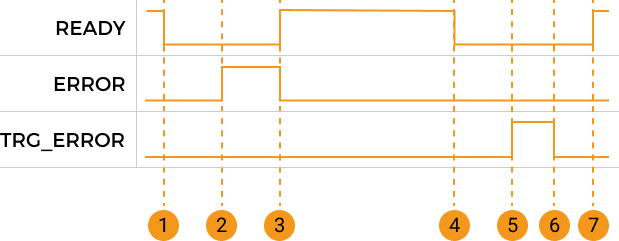Output Signals to External Device
This topic introduces how to output signals to external devices through the predefined output signal terminals on the controller. These signals serve two main purposes:
-
They provide the data acquisition status of the laser profiler to external devices, enabling the design of corresponding control logic.
-
They output other signals to external devices, with signal meanings configurable via the API.
Relevant Output Signal Terminals
The following output signal terminals are discussed in this topic:
| No. | Name |
|---|---|
17–20 |
COM_OUT, common terminal for output signal |
21–28 |
O1–O8, universal digital outputs 1–8, optocoupler isolation, NPN output. |
29 |
READY |
30 |
ERROR |
31 |
TRG_ERROR |
Provide Data Acquisition Status Signals to External Device
READY
The signals output by the READY terminal are as follows:
-
When the laser profiler has entered the acquisition ready status but is not acquiring data, the READY terminal outputs logical HIGH signal.
-
The READY terminal outputs logical LOW signal when the laser profiler is acquiring data.
| For the procedure of entering the laser profiler into the acquisition ready status with different triggering methods, please refer to Workflow of Triggering Data Acquisition. |
ERROR
The signals output by the ERROR terminal are as follows:
-
When the laser profiler has entered the acquisition ready status but is not acquiring data, and when the laser profiler is acquiring data normally, the ERROR terminal outputs logical LOW signal.
-
When the following errors occur during data acquisition, the ERROR terminal outputs logical HIGH signal until the current round of data acquisition ends.
-
The acquired data is not received within the set Timeout Period.
-
When Line Scan Trigger Source is set to Software, the data acquisition is not successfully started.
-
| For the procedure of entering the laser profiler into the acquisition ready status with different triggering methods, please refer to Workflow of Triggering Data Acquisition. |
TRG_ERROR
The signals output by the TRG_ERROR terminal are as follows:
-
When the laser profiler has entered the acquisition ready status but is not acquiring data, and when the laser profiler is acquiring data normally, the TRG_ERROR terminal outputs logical LOW signal.
-
When the laser profiler receives another data acquisition trigger signal while acquiring data, the TRG_ERROR terminal outputs logical HIGH signal until the trigger signal disappears.
| For the procedure of entering the laser profiler into the acquisition ready status with different triggering methods, please refer to Workflow of Triggering Data Acquisition. |
Example
The correspondence between the terminal signals and data acquisition status is explained using the following figure as an example, in the order of the logic level change of the terminal signals.

| No. | Data acquisition status | Signal logic level |
|---|---|---|
1 |
The first round of data acquisition is started. |
READY: changes from HIGH to LOW. |
ERROR: remains LOW. |
||
TRG_ERROR: remains LOW. |
||
2 |
An error occurs during data acquisition. |
READY: remains LOW. |
ERROR: changes from LOW to HIGH. |
||
TRG_ERROR: remains LOW. |
||
3 |
The first round of data acquisition is stopped. |
READY: changes from LOW to HIGH. |
ERROR: changes from HIGH to LOW. |
||
TRG_ERROR: remains LOW. |
||
4 |
The second round of data acquisition is started. |
READY: changes from HIGH to LOW. |
ERROR: remains LOW. |
||
TRG_ERROR: remains LOW. |
||
5 |
Another data acquisition trigger signal is received during ongoing data acquisition. |
READY: remains LOW. |
ERROR: remains LOW. |
||
TRG_ERROR: changes from LOW to HIGH. |
||
6 |
The data acquisition trigger signal disappears. |
READY: remains LOW. |
ERROR: remains LOW. |
||
TRG_ERROR: changes from HIGH to LOW. |
||
7 |
The second round of data acquisition is stopped. |
READY: changes from LOW to HIGH. |
ERROR: remains LOW. |
||
TRG_ERROR: remains LOW. |